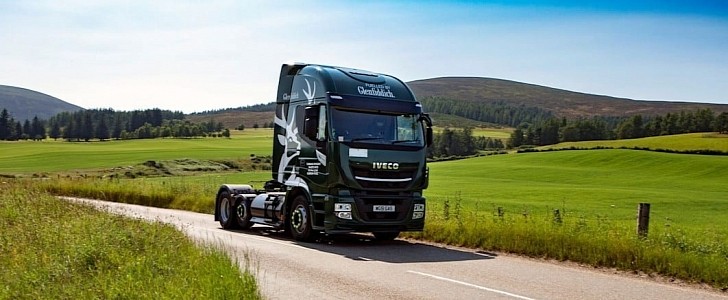Trucks are essential to our day-to-day lives, and they produce their share of emissions. Before all of them get replaced by electric equivalents, are there any solutions to reduce their CO2 footprint? A Scottish whisky manufacturer has employed an alternative fuel for its delivery trucks, and it brings a 95 percent CO2 emissions reduction when compared to diesel or other fossil fuels.
What is even more impressive is that the alternative fuel employed in the Iveco Stralis NP 460 trucks cuts down greenhouse gas emissions by up to 99 percent. Furthermore, the fuel is sourced from whisky production waste and residues, which closes the production loop of the company.
Scottish whisky brand Glenfiddich is the first to use the Ultra-Low Carbon Fuel (UCLF) and they installed fueling stations for their trucks at the company's Dufftown distillery in Scotland. The brand is owned by William Grant & Sons, and representatives explained that the waste and residues from the whisky manufacturing process were traditionally sold to be used as high-protein cattle feed.
So, how do whisky production waste and residues get turned into fuel? Spent grains leftover from the malting process is broken down by bacteria through anaerobic digestion. The result of that process produces biogas, and liquid waste can be introduced into the process to make fuel for the company's delivery trucks.
With this process, the distillery gets to recycle all its waste products, which is impressive. The Scottish whisky industry wants to be carbon net-zero by 2040, as Reuters notes, so this implementation is a big step in that direction.
Eventually, the process will be implemented in all the distilleries owned by William Grant & Sons, and other companies could also benefit from the technology. For now, only 20 trucks have been converted to run on the new ULCF gas, and each of those trucks displaces 250 tons of CO2 annually.
The Iveco Stralis NP 460 trucks employed as delivery trucks worked on natural gas, so the conversion process was simplified when compared to a conventional diesel truck. The Stralis 460 can deal with light off-road missions but is engineered to operate mostly on-road. It can drive up to 1,600 kilometers (1,000 miles) on a single fill-up, so most of the company's deliveries can be handled in a CO2-neutral manner.
Scottish whisky brand Glenfiddich is the first to use the Ultra-Low Carbon Fuel (UCLF) and they installed fueling stations for their trucks at the company's Dufftown distillery in Scotland. The brand is owned by William Grant & Sons, and representatives explained that the waste and residues from the whisky manufacturing process were traditionally sold to be used as high-protein cattle feed.
So, how do whisky production waste and residues get turned into fuel? Spent grains leftover from the malting process is broken down by bacteria through anaerobic digestion. The result of that process produces biogas, and liquid waste can be introduced into the process to make fuel for the company's delivery trucks.
With this process, the distillery gets to recycle all its waste products, which is impressive. The Scottish whisky industry wants to be carbon net-zero by 2040, as Reuters notes, so this implementation is a big step in that direction.
Eventually, the process will be implemented in all the distilleries owned by William Grant & Sons, and other companies could also benefit from the technology. For now, only 20 trucks have been converted to run on the new ULCF gas, and each of those trucks displaces 250 tons of CO2 annually.
The Iveco Stralis NP 460 trucks employed as delivery trucks worked on natural gas, so the conversion process was simplified when compared to a conventional diesel truck. The Stralis 460 can deal with light off-road missions but is engineered to operate mostly on-road. It can drive up to 1,600 kilometers (1,000 miles) on a single fill-up, so most of the company's deliveries can be handled in a CO2-neutral manner.










